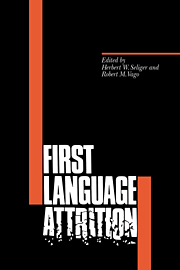Book contents
- Frontmatter
- Contents
- List of figures
- List of tables
- List of contributors
- Acknowledgment
- Part I Survey studies
- Part II Group studies
- Part III Case studies
- 12 Morphological disintegration and reconstruction in first language attrition
- 13 Assessing first language vulnerability to attrition
- 14 Compensatory strategies of child first language attrition
- 15 Language attrition, reduced redundancy, and creativity
- 16 Paradigmatic regularity in first language attrition
- Index
12 - Morphological disintegration and reconstruction in first language attrition
Published online by Cambridge University Press: 14 January 2010
- Frontmatter
- Contents
- List of figures
- List of tables
- List of contributors
- Acknowledgment
- Part I Survey studies
- Part II Group studies
- Part III Case studies
- 12 Morphological disintegration and reconstruction in first language attrition
- 13 Assessing first language vulnerability to attrition
- 14 Compensatory strategies of child first language attrition
- 15 Language attrition, reduced redundancy, and creativity
- 16 Paradigmatic regularity in first language attrition
- Index
Summary
Introduction
The need for long term longitudinal studies of attrition within individuals has long been recognized in attrition (Obler 1982; Weltens 1987). Such longitudinal studies allow insight into the cumulative effects of attrition on the linguistic features of the language involved. This chapter is devoted to one such study. The developmental attrition of L1 (Hebrew) in a young child placed in an L2 (English) dominant environment has been monitored longitudinally through naturalistic observations and systematic probes to study the effect of attrition on the lexicon, syntax, morphology, and phonology of L1. The present contribution highlights one aspect of this study – the disintegration and reconstruction of the L1 verbal system. The study is based on daily notes and bi-weekly recordings of primarily naturalistic observations as well as on occasional elicitation activities and probes designed to ascertain the child's competence in L1. The data were collected primarily in the home environment where the use of L1 dominated.
The study focuses on instances of code mixing, where linguistic units (words, phrases, clauses) of one language are juxtaposed with units of another language within a single sentence (Sridhar & Sridhar 1980), and code blending, where morphemes from one language are combined with morphemes of another language within a single word while the phonological features of the respective source languages are retained (Kaufman & Sridhar 1986). Given that code blended words are necessarily of the child's own creation, it follows that code blending provides a window into the child's morphological competence (Aronoff 1983, 1976).
- Type
- Chapter
- Information
- First Language Attrition , pp. 175 - 188Publisher: Cambridge University PressPrint publication year: 1991
- 38
- Cited by

